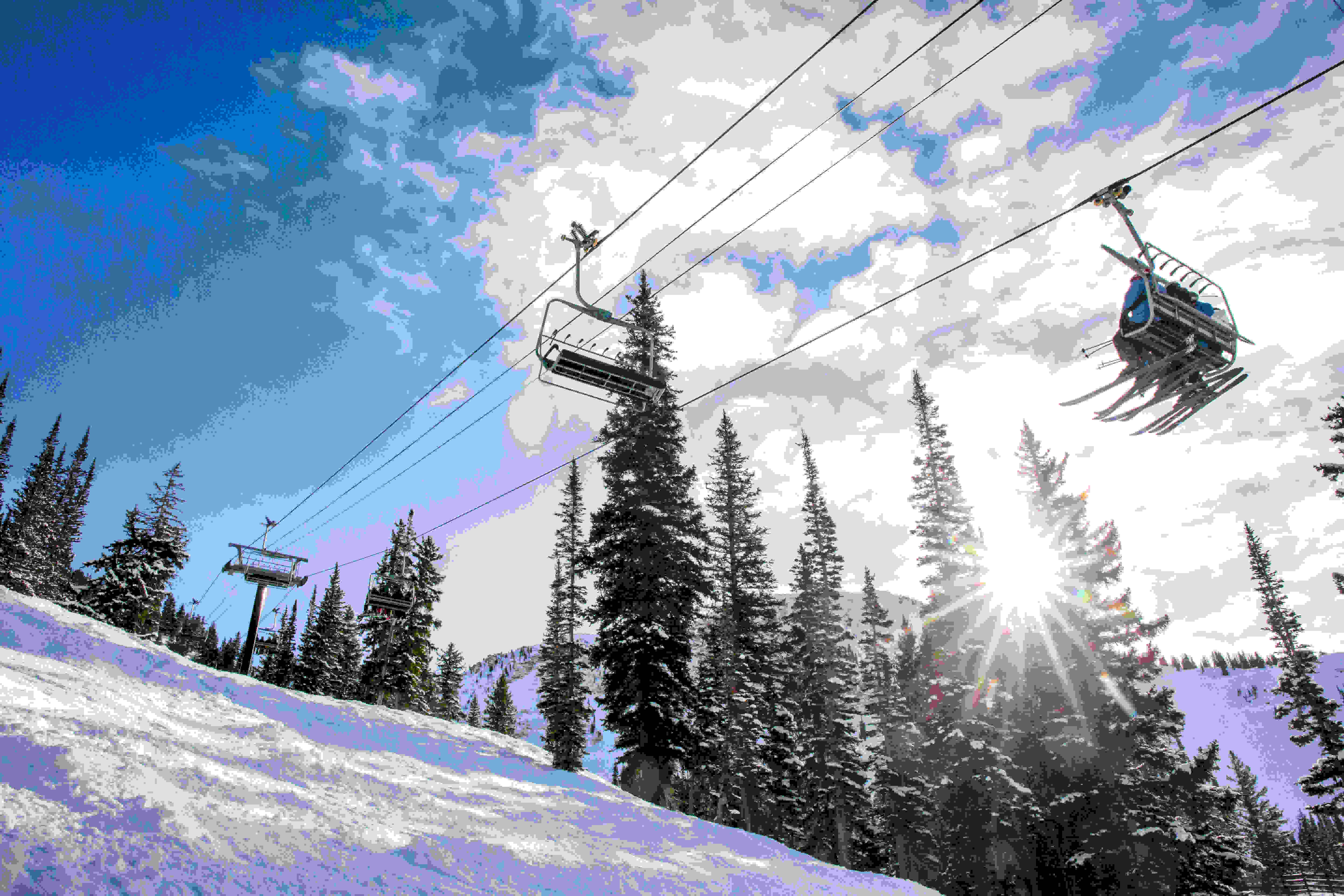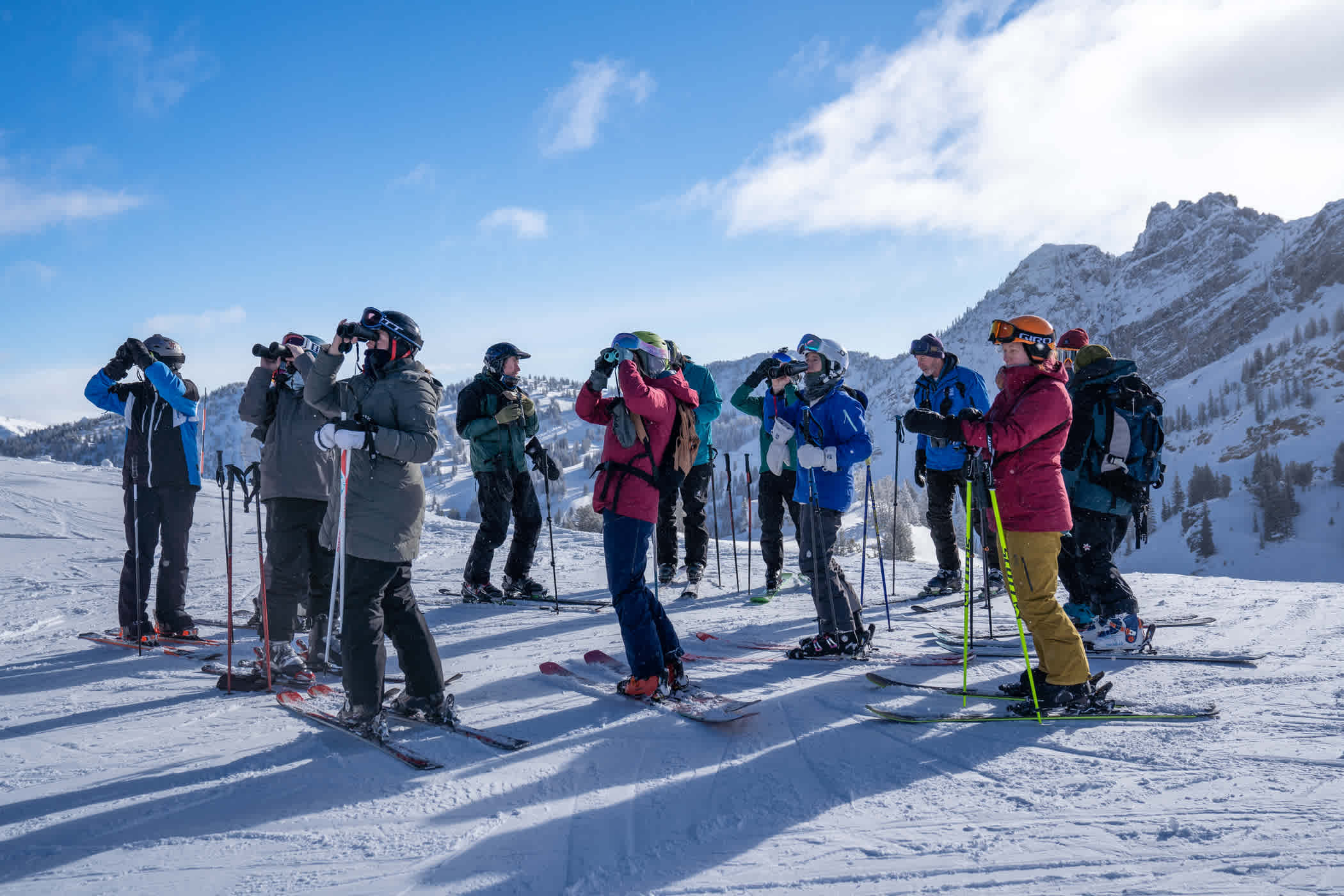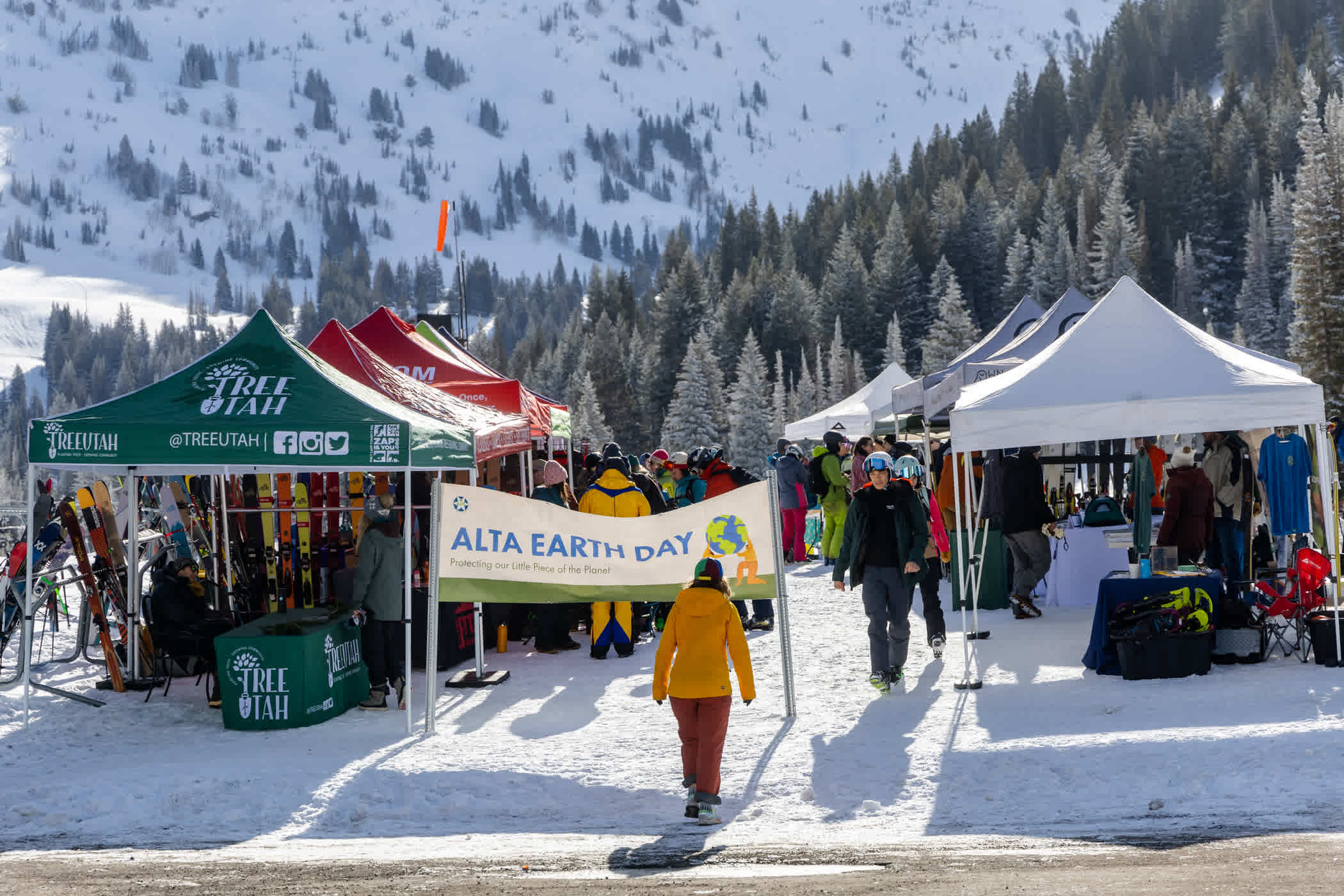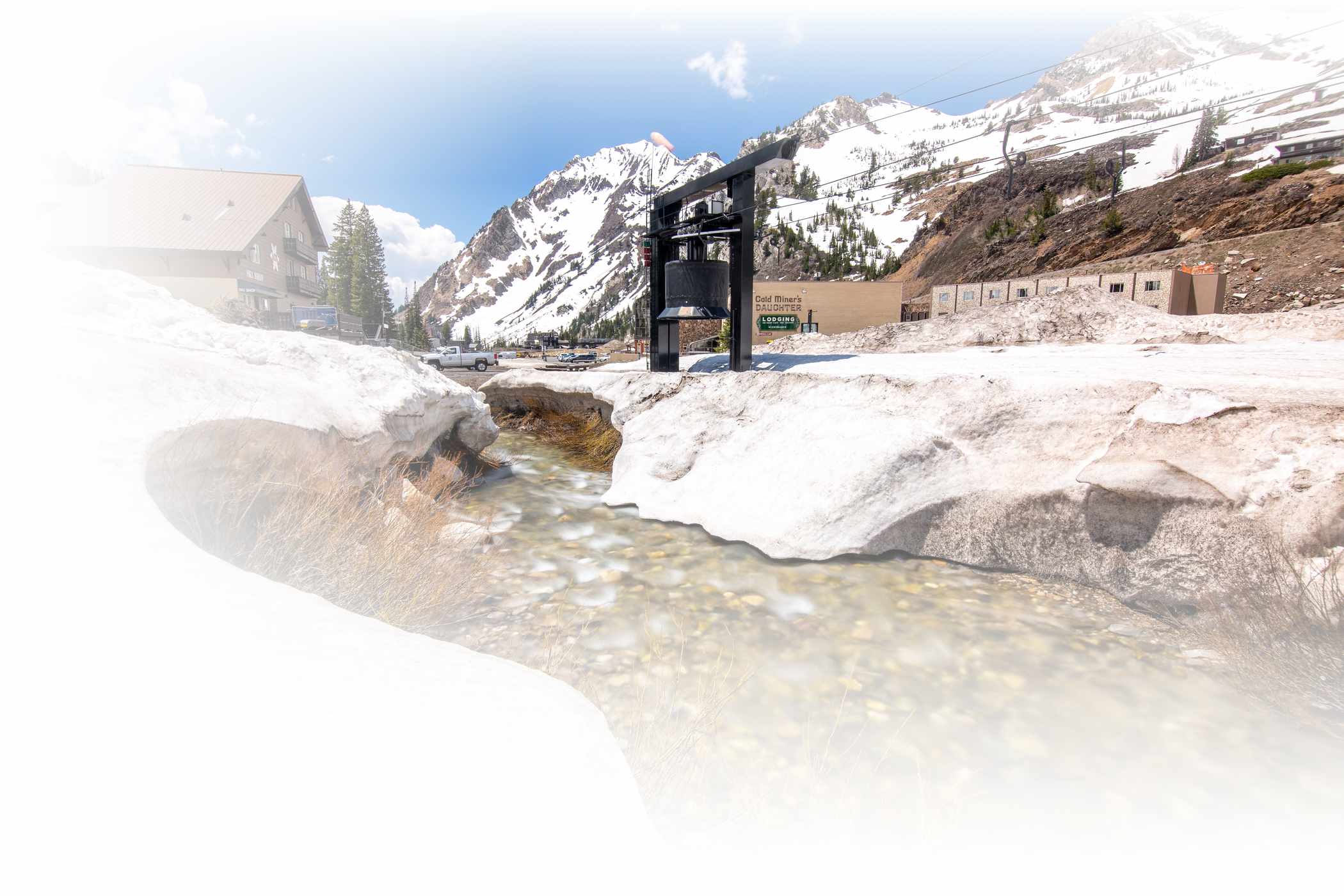issue no. 101
Download the Spring 2023 Newsletter
WINTER 2022–23 RECAP
For those of us who committed the last six months to skiing in Little Cottonwood Canyon, we are no strangers to this record snow year. Road closures, midday interlodges, and seemingly endless powder days will remain in our minds for decades to come. As our winter season ends, we reflect on the past six months and recognize the hard work it took from our community and partners to successfully run our Food Waste Management program, host on-snow educational events, and continue our mission to provide alpine skiing in a natural mountain environment.
We also turn our attention to the warmer months ahead, underneath this year’s record 200-inch base lies a complex ecosystem of diverse plant communities and habitats that are under Alta Ski Area’s umbrella of preservation. We check in with Matthew from Dryland Horticulture, our local horticulturist who carefully grows over 12,000 native plants from handpicked seed harvested in the fall - later to be brought up to Alta’s on-site nursery and planted throughout Alta in the summer. Check out our upcoming summer stewardship events calendar and get involved with us this season!

Educational Skecology Sign Nearly Buried | Photo: Chloe Jimenez
food waste management program
Alta Ski Area’s food waste management program is an important component of the Alta Environmental Center’s (AEC) broader mission to promote sustainable practices. Momentum Recycling is a local, zero-waste recycling facility that collects food waste from Alta Ski Area and brings it to Wasatch Resource Recovery, a local organization that specializes in organic waste management and operates an anaerobic digester. This facility processes and converts organic waste into two products: renewable biogas that can be used to generate electricity, heat, or fuel, and a nutrient-rich compost used for agricultural and landscaping purposes.
By partnering with both Momentum Recycling and Wasatch Resource Recovery, Alta Ski Area is effectively diverting food waste from entering the landfill, reducing greenhouse gas emissions, and minimizing our environmental impact. Furthermore, this program is a building block in our commitment to environmental stewardship and our dedication to promoting sustainable practices in the ski industry. This collection program works because of the dedication and flexibility of the employees and leaders in our food and beverage locations. Alf’s, Watson’s Shelter, Albion Grill, and the Buckhorn are the hard-working staples of this program. Thank you!

renewable energy credits
To effectively manage the ski area’s carbon footprint, the AEC carefully monitors and calculates the emissions produced by resort operations. This includes tracking energy use, transportation emissions, waste generation, and other factors. By analyzing this data, we are able to identify areas where emissions and costs can be reduced and implement strategies to minimize our environmental impact. The ski area relies heavily on the use of electricity to run essential on-mountain operations such as lifts, snowmaking, and operating equipment. When exploring a comprehensive approach to acquiring renewable energy, we had to take into account the ski area’s remote location. Alta Ski Area chose to purchase Renewable Energy Credits (RECs) to support renewable energy production and offset our carbon emissions. Each REC represents one megawatt-hour of electricity produced through a wind or solar facility, and each of those RECs is available for purchase.

In January 2022 Alta Ski Area committed to match 100% of its annual electricity use with renewable energy through the purchase of RECs through 2024. These RECs are purchased directly from Rocky Mountain Power’s Blue Sky program, a Green-E Energy certified program by the Center of Resource Solutions. The Blue Sky program not only supports renewable energy farms local to Utah, but also funds renewable energy projects at organizations vital to the fabric of our community. Schools, homeless shelters, food banks, libraries, fire stations, and community centers have been able to add renewable energy projects to their facilities thanks to the Blue Sky program. These community-based energy projects support cleaner air and address equity and sustainability closer to home.
Overall, by purchasing RECs we are supporting the demand and growth of renewable energy production and directly offsetting our carbon use by supporting the production of renewable energy elsewhere. Overall, our commitment to match 100% of the ski area’s electricity use is estimated to reduce our carbon footprint by 3,567 metric tons of carbon dioxide per year.

In January 2022 Alta Ski Area committed to match 100% of its annual electricity use with renewable energy through the purchase of RECs through 2024 | Photo: Rocko Menzyk
winter educational events recap

Birding on Skis with Tracy Aviary | Photo: Chloe Jimenez
The incredible snowpack that was delivered in the 2022–23 season also brought some challenges to our on-snow education events. Thanks to our guides and participants, we were able to work around mother nature’s plan. This season we hosted:
Hosted five with a total of 55 participants over the season. Due to Sunnyside Lift construction and the record snow, we faced some challenges with hosting our tours twice monthly, but thanks to our partners at Tracy Aviary we were able to remain flexible and go birding!
In partnership with TreeUtah we hosted seven Trees and Skis, twice monthly starting in January. Thanks to Ian Peisner, TreeUtah’s expert arborist, we were able to work around the Sunnyside Lift construction and host new tours off Supreme for the first month.
In partnership with Cottonwood Canyons Foundation (CCF) volunteer naturalists led these tours were offered once a month. Each tour date was a beautiful bluebird day spent outside learning about the natural environment around us. In collaboration with CCF we hosted a tour with Latinos Outdoors in April.
A total of nine Saturday afternoon tours were hosted by CCF off the Sunnyside lift this winter. Thank you to the incredible naturalists who lead our skiers!
Our 14th annual community Alta Earth Day was hosted on April 15th, 2023. It turned out to be a beautiful, sunny day. This event encourages environmental stewardship, diversity in outdoor recreation, responsible recreation, and awareness of the relationship between climate change and the future of the ski industry in Little Cottonwood Canyon and beyond. This year was our largest event yet, with 19 vendors representing sustainable businesses, local non-profits, and our partner organizations. Six on-snow educational events were hosted throughout the day with our partners. We had an incredible day celebrating and are so grateful to our partners and our community’s efforts in helping us conserve and protect our little piece of the planet.

14th Annual Alta Earth Day | Photo: Photo–John
catching up with dryland horticulture
Matthew Utley of Dryland Horticulture has spent thirty years working in the field of conservation horticulture. In 2010, the Alta Environmental Center (AEC) partnered with Matthew to develop our revegetation protocol. Matthew’s guidance and extensive knowledge of collecting, propagating, and growing our seed has been a pillar in the development of our large-scale operation at work today.
The 12,740 plants grown at Dryland Horticulture will go into Alta’s landscape at sites where disturbance has occurred. Each of these was grown from seed collected by AEC staff in the fall and grown by Matthew over the winter. Quite an enormous feat for most—but this is Matthew’s passion. For him growing upwards of 12,000 native wildflowers and shrubs for Alta is a relaxing side hustle that he comes home to after a long day at his day job, which is the Vice President/Director of Operations at Tracy Aviary.
Using locally adapted plants is an important element of our revegetation program and restoration work. This process ensures the plants have the same genetic makeup as surrounding populations, increasing survival rates and long-term success.
Growing these plants starts in the fall and is a complex process—Matthew is tasked with trying to get plants to germinate and grow outside of their natural environment—then place seedlings into pots in time for delivery each spring. Assessing and cleaning seed the seed, germination, vegetative growth, and transplanting are four crucial stages that each require their own conditions and determining factors. As Matthew puts it,
“You have to put yourself in the plant’s shoes - if I’m growing Parry’s primrose I imagine myself laying down in a scree field and picture what conditions I am receiving that makes this species happy and then try and recreate those conditions in a completely different environment.”
Once the plant has germinated, Matthew then adjusts the conditions. Temperature, sunlight, wind, and the amount of water the plants receive are considered when meeting the needs of the seedling. Pop-up tents and temporary greenhouses are used to provide the correct growing environment and a special netting is used to keep birds and squirrels out. Years of experimentation, creativity, and flexibility in constant change are part of Matthew’s specialty, and what makes him so great in this field. To put it simply, Matthew has to know what fifty different types of species need, and then do his best to meet the needs of each plant with the least amount of effort.


Matthew's daughter, Aidan, watering the nursery in Sugarhouse, SLC (left) Seedlings in pots at Dryland Horticulture nursery before being transported to Alta's nursery.
Growing native plants is not something that can only be done at Alta. Planting native species in your own backyard or a park is something that can be done by you too. You don’t have to hike a long way to find enjoyment in the beauty of nature, putting indigenous species in your own garden is a journey of enjoying nature and understanding the complex ecosystems that surround your everyday life. As Matthew explained,
“Imitation is the greatest form of flattery. By grasping a greater depth of understanding of the birds, insects, and plants in our daily lives we can go deeper into nature. You can find so much enjoyment in your backyard or a small park just by striving to understand how native species function in the ecosystem. We can all find a deeper appreciation of each organism’s place in the ecosystem by diving deeper into this.”
A greater understanding leads to a greater appreciation and we are so thankful to Matthew for his guidance and for helping the AEC evolve its revegetation program into the success it is today. With warmer months ahead we are looking forward to getting our hands in the dirt.
*Alta’s revegetation program and partnership with Dryland Horticulture works in conjunction with landowners, Alta Ski Area, and the US Forest Service. This program follows a set of protocols in which every handpicked seed is put back into Alta’s landscape to contribute to the restoration of ecosystem functions and recovery at sites of disturbance within the ski area.
Summer stewardship


Add Your Comment